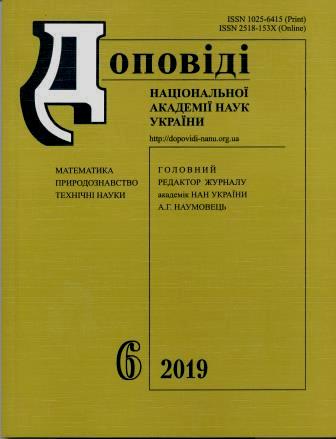Вплив сонячної енергії на самоорганізацію молекул води. Добові, річні та 11-річні варіації
DOI:
https://doi.org/10.15407/dopovidi2019.06.061Ключові слова:
11-річні цикли, водні кластери, гідроліз, сонячна енергія, циркадні ритми, циркануальні ритмиАнотація
Сонячна енергія сильно впливає на здатність молекул води до самоорганізації. Це виявляється в хімічній активності водних кластерів. Швидкість гідролітичних процесів за участі водних кластерів може змі- нюватися в дуже широких межах протягом хвилин, годин, днів, місяців та років. Результати регулярних 4-річних (2015—2018) досліджень гідролізу триетилфосфіту вказують на те, що швидкість цієї реакції за всіх однакових умов має добові і річні варіації, а також модулюється 11-річними циклами сонячної активності. Гідролітичний розрив фосфор-кисневого зв’язку в триетилфосфіті можна розглядати як спро- щену модельну систему для перетворення аденозинтрифосфату (АТФ) в аденозиндифосфат (АДФ), який, як відомо, лежить в основі біоенергетичних процесів у живих організмах. Залежність біохімічних процесів від сонячної активності внаслідок обертання Землі навколо своєї осі та навколо Сонця добре відома у всіх формах життя (рослинах, тваринах, грибах та бактеріях) як циркадні та циркануальні ритми. Напри- клад, внаслідок 11-річних циклів сонячної активності річні кільця в стовбурах дерев мають різну товщину та упорядковані в 11-річні послідовності. Беручи до уваги те, що вода є необхідною складовою частиною у всіх формах життя, можна припустити, що знайдені добові та річні варіації активності води можуть лежати в основі циркадних та циркануальних ритмів.
Завантаження
Посилання
Shevchenko, I. V. (2016). Influence of geoelectric field on chemical reactions on Earth. Dopov. Nac. akad. nauk Ukr., No. 9, pp. 110-117. doi: https://doi.org/10.15407/dopovidi2016.09.110
Space Weather Phenomena. NOAA/NWS Space Weather Prediction Center. Retrieved from http://www.swpc.noaa.gov/phenomena
Lehninger, A. L. (1975). Biochemistry. 2nd ed. New York: Worth Pabl. Inc.
Metzleer, D. E. (1977). Biochemistry. The Chemical Reactions of Living Cells. New York: Academic Press.
Johnsson, A. (2008). Light, circadian and circannual rhythms. In Solar radiation and human health, Bjertness, E. (Ed.) (pp. 57-75). Oslo: The Norwegian Academy of Science and Letters.
Luthardt, L. & Rößler, R. (2017). Fossil forest reveals sunspot activity in the early Permian. Geology, 45, No. 3, pp. 279-282. doi: https://doi.org/10.1130/G38669.1
Ludwig, R. (2001). Water: From clusters to the bulk. Angew. Chem. Int. Ed. Engl. 40, pp. 1808-1827. doi: https://doi.org/10.1002/1521-3773(20010518)40:10<1808::AID-ANIE1808>3.0.CO;2-1
Keutsch, F. N. & Saykally, R. J. (2001). Water clusters: Untangling the mysteries of the liquid, one molecule at a time. Proc. Natl. Acad. Sci. USA, 98, No. 19, pp. 10533-10540. doi: https://doi.org/10.1073/pnas.191266498
Duan, Ch., Wie, M., Guo, D., He, Ch. & Meng, Q. (2010). Crystal structures and properties of large protonated water clusters encapsulated by metal-organic frameworks. J. Am. Chem. Soc., 132, pp. 3321-3330. doi: https://doi.org/10.1021/ja907023c
Liu, K., Brown, M.G., Cruzan, J. D. & Saykally, R. J. (1996). Vibration-rotation tunneling spectra of the wa ter pentamer: Structure and dynamics. Science, 271, pp. 62-64. doi: https://doi.org/10.1126/science.271.5245.62
Nauta, K. & Miller, R. E. (2000). Formation of cyclic water hexamer in liquid helium: The smallest piece of ice. Science, 287, pp. 293-295. doi: https://doi.org/10.1126/science.287.5451.293
Huisken, F., Kaloudis, M. & Kulcke, A. (1996). Infrared spectroscopy of small size-selected water clusters. J. Chem. Phys., 104, pp. 17-25. doi: https://doi.org/10.1063/1.470871
Shevchenko, I. V. (2017). Influence of light on chemical reactivity of water clusters. Cornell University Archives. arXiv:1706.02148 [physics.chem-ph]. Retrieved from http://www.arxiv.org/abs/1706.02148
##submission.downloads##
Опубліковано
Як цитувати
Номер
Розділ
Ліцензія
Авторське право (c) 2024 Доповіді Національної академії наук України

Ця робота ліцензується відповідно до Creative Commons Attribution-NonCommercial 4.0 International License.




